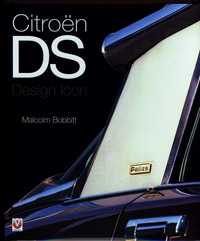|
||||||||||||||||||||||
Citroën DS
Design Icon

|
Author |
Malcolm Bobbitt |
|
Publisher |
Veloce Publishing Ltd |
|
|
33 Trinity Street |
|
|
Dorchester |
|
|
Dorset |
|
|
DT1 1TT |
|
|
England |
|
|
Tel : +44 1305 260068 |
|
|
Fax : +44 1305 268864 |
|
|
|
|
Published |
May 2016 UK |
|
ISBN |
9781845842765 |
|
UPC |
6-36847-04276-9 |
|
Price (as at June 2005) |
GBP27.50 UK |
|
|
USD50.00 USA |
May 2016 - Available again after
a long absence!
The most radical of Citroën’s idiosyncratic offerings, the DS was
sensational when it was introduced in 1955. Twenty years and 1.45
million cars later it was still technically advanced in relation
to
most other cars. Revolutionary in driving characteristics and
comfort,
it remains one of the most innovative cars of all time.
In this book Malcolm Bobbitt, a well-known motoring author and DS
owner, gives an in-depth guide to the Citroën DS - its history,
design
and specifications, as well as valuable advice for buyers and
owners.
This long overdue revised edition contains much new and updated
information.
As every Citroën enthusiast must be aware, 2005 represents the
fiftieth anniversary of the launch of the DS. I had fully
expected a plethora of new books on the subject but surprisingly
there
appears to be only this one new English language work available.
I must admit I approached this book with mixed feelings.
Malcolm is a friend of mine and if truth be told, his
last book on the DS
disappointed me. At the time, I asked the question
“Does
the world need another book about the DS?” and inevitably I
repeated
this question to myself this time round. The story of the DS
has
been exhaustively covered already and there can’t possibly be
anything
new to write about.
But then it occurred to me that this book does
have a market since John Reynolds’ masterpiece is long out of
print and
most of the rest of the DS books available are in French.
The book is beautifully presented with 225 colour and 50
monochrome
pictures; many of which have not been seen before. The book
covers the development of prototypes and production cars with all
the
variants being covered and, unlike John Reynolds’ book, an entire
chapter is dedicated to the car’s not inconsiderable sporting
achievements. The SM (sadly without any pictures of the
DSport or
the development mules) is also given a chapter, as are the DS’
contemporary rivals. There is a chapter that provides useful
hints on buying and running a DS together with a useful list of UK
businesses and clubs that can assist.
I have but two minor gripes: the lack of serial numbers to assist
in
identification; and the lack of an in-depth technical explanation
of
the hydraulic system.
Even if the story is familiar to many, there are plenty out there
who
will take delight in discovering for the first time the twists and
turns that led to the creation of an unique motor car. Those
who
already know the story will still find fresh revelations in these
pages
and Malcolm’s easy prose and the mix of fresh and familiar
pictures,
together with a refreshing lay out make this book a joy to own.
This book comes strongly recommended.
Julian Marsh
June 2005

